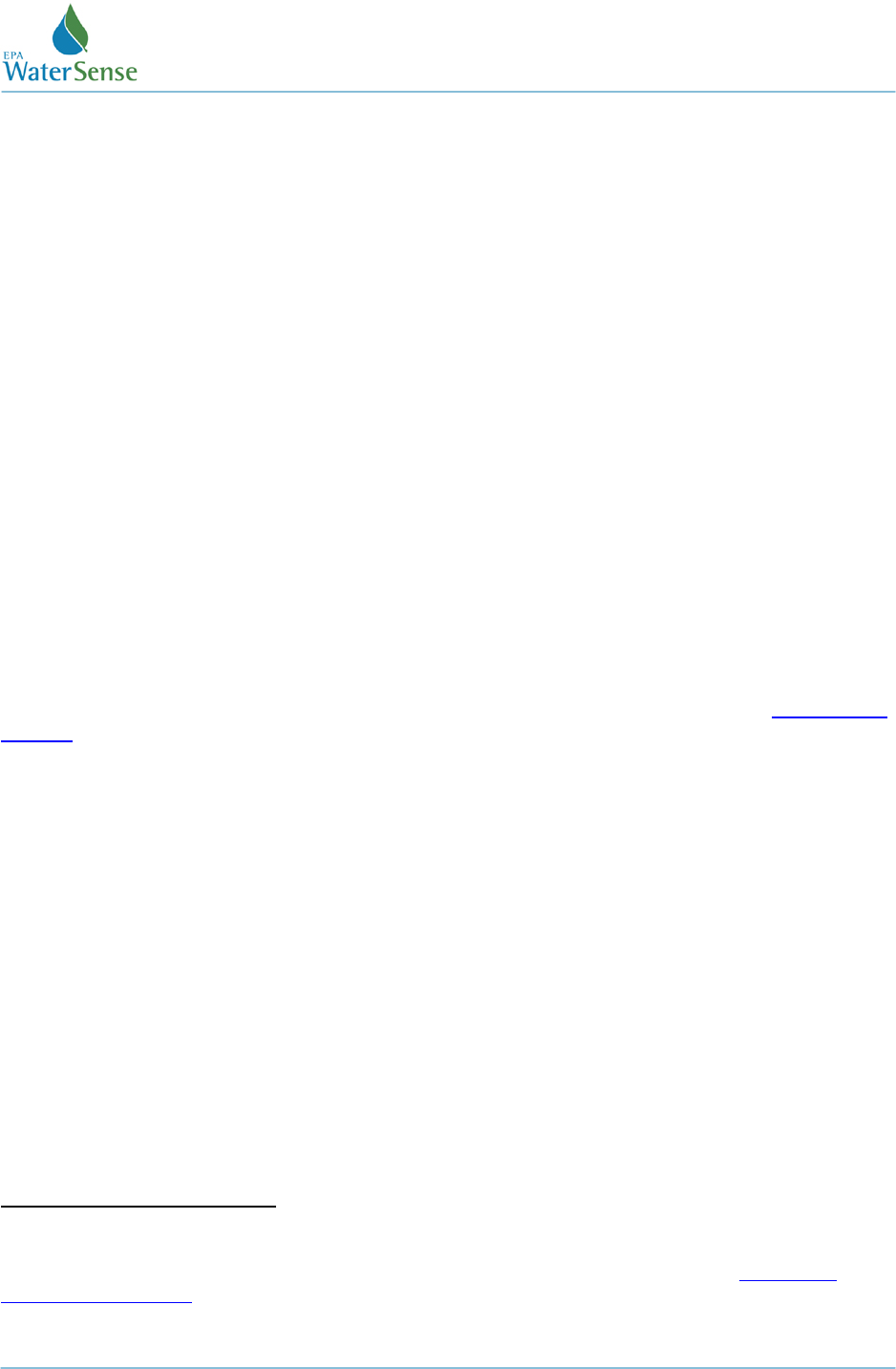
WaterSense
®
Water Budget Approach
WaterSense
®
Water Budget Approach
The WaterSense New Home Specification defines the criteria a home must meet in order to
earn the WaterSense label. It addresses indoor water use, outdoor water use, and homeowner
education.
To meet the specification’s Landscape Design Criteria (Section 4.1.1), the builder must design
the landscaped area using the WaterSense Water Budget Tool. The Water Budget Tool guides
the builder, landscape professional, or irrigation professional certified by a WaterSense labeled
program
1
through the water budget calculations. This document provides an overview of the
tool, as well as detailed instructions for using the tool. The builder shall submit a copy of the
completed Excel tool or a copy of the Water Budget Tool Report generated by the Web-based
version of the tool as part of the inspection package.
I. Background
The water budget approach serves as a design tool, allowing the professional to design a
sustainable landscape based on a regionally appropriate amount of water. A water budget is a
site-specific method of calculating an allowable amount of water to be used by the landscape
and then designing the landscape to meet this budget. The budget takes into account plant
type, plant water needs, irrigation system design, and applied water that the landscape receives
either by irrigation or by precipitation, as described in detail below. Water budgets must be
associated with a specified amount of time, such as a week, month, or year.
The tool, available both online and as a Microsoft Excel spreadsheet format on the
WaterSense
website, guides the user through the water budget calculation in three parts. First, the tool
calculates the amount of water a standard landscape would require and the amount of water the
designed landscape is allowed in order to be considered water-efficient. Next, the tool
calculates how much water the designed landscape requires based on climate, plant type, and
irrigation system design. Lastly, it determines whether the designed landscape meets EPA’s
criteria.
The WaterSense program considers two major factors when designing specifications for water
efficiency: water use and performance. In order to be eligible for labeling, products must use
less water while performing as well as or better than conventional models. Performance of a
landscape can be judged by the presence of healthy plants and the ability to meet user
expectations for both functionality and aesthetic effects. It is important to ensure that every plant
can have access to the water it needs or it will affect both aspects of the performance
concerns—the health of the plant and the aesthetic quality of the landscape. For purposes of
the specification, it was determined that a performance-based approach to compliance, i.e.,
designating a water allotment and allowing the landscape designer to meet it in any number of
ways, would allow the most flexibility and ease of meeting the criteria. The allotment approach
means that the builder or landscape professional must put thought into the landscape plan. This
1
An irrigation professional certified by a WaterSense labeled program (i.e., certified irrigation
professional) has demonstrated an expertise in water-efficient irrigation technology and techniques. A
listing of eligible certified irrigation professionals can be found by visiting WaterSense’s
Directory of
Certified Professionals.
Version 1.02 1 July 24, 2014
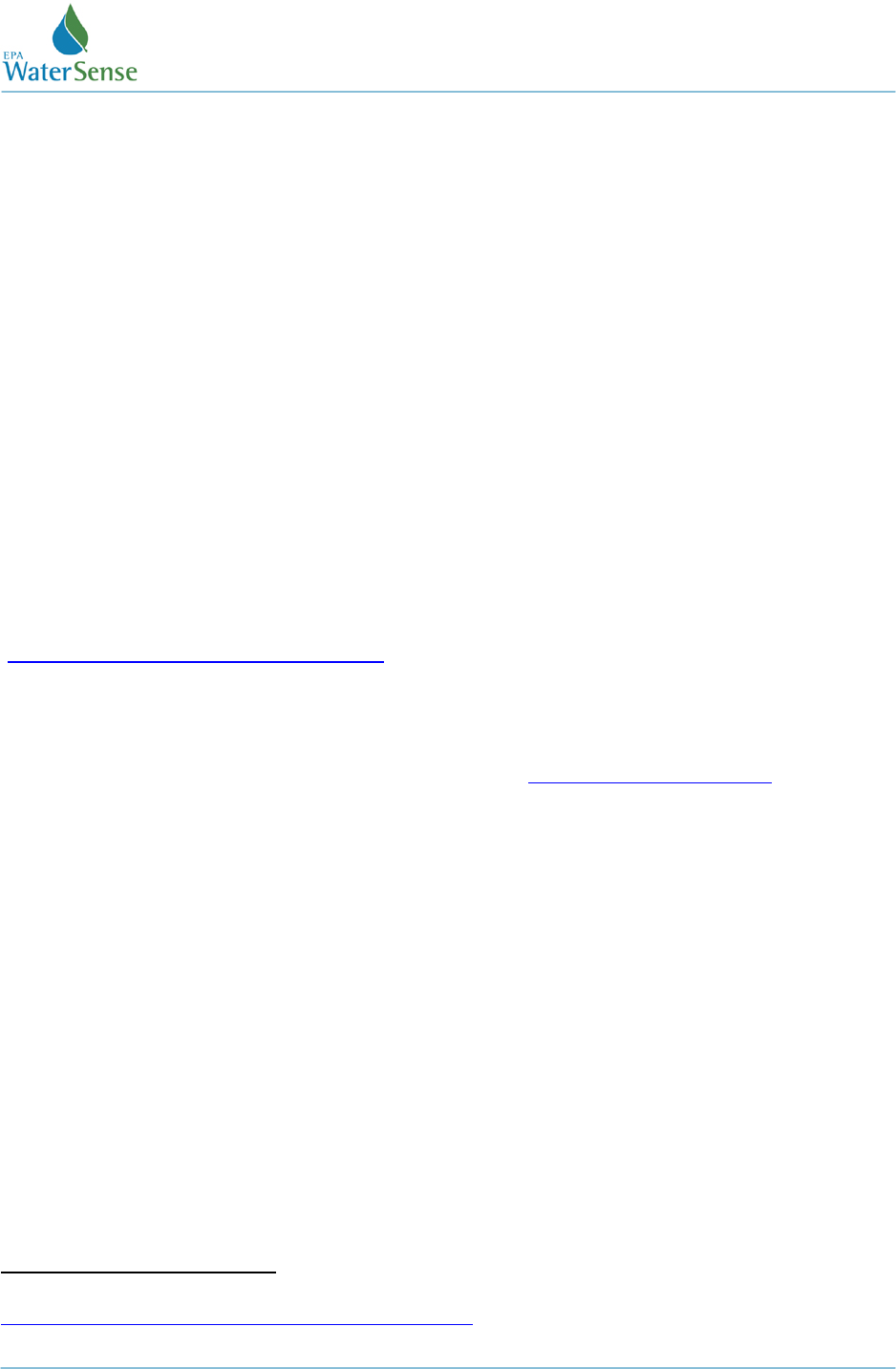
WaterSense
®
Water Budget Approach
is likely to lead to a landscape that has more “curb appeal” and increases the value of the home,
benefiting both the environment and the homeowner.
WaterSense chose a well-maintained lawn composed entirely of cool season turfgrass as the
baseline, or conventional, model and a 30 percent reduction in associated water use as the
reduction that would result in water efficiency. This does not mean that WaterSense believes a
lawn should be watered with 70 percent of the water it requires, but that a plant mix should be
selected that would use 30 percent less water than a landscape composed entirely of turf. The
data used to calculate water use, discussed below, is modeled across the entire United States
by zip code, resulting in site-specific allotments. Therefore, while everyone must achieve the
same minimum percentage reduction, the actual requirement, in gallons of water, varies greatly
based on what is appropriate for each region. Additionally, the data are conservative in nature in
order to result in a landscape capable of withstanding the most challenging months of the year.
Data
The tool requires two climate-based inputs in addition to the types of vegetation planted and the
types of irrigation equipment installed. These two climate-based inputs are local reference
evapotranspiration (ET
o
) and rainfall. In order to make an easy-to-use tool, it was imperative to
have a standardized set of data that covered the entire country. While there are numerous local
sources of rainfall data, local ET
o
, data sets are scarce. However, the International Water
Management Institute (IWMI) produced a World Water and Climate Atlas
(www.iwmi.cgiar.org/WAtlas/Default.aspx
) that used 1961–1990 weather station data across the
world to model monthly summary data for a number of parameters, including standardized
Penman-Monteith reference evapotranspiration rates. The U.S. data were extracted and
summarized with an average value for each zip code using ESRI ArcGIS version 9.3.
2
In order
to be consistent, both in terms of actual data and the process used to model it, WaterSense also
extracted the 1961–1990 precipitation data to create the Water Budget Data Finder
. After the
user enters a zip code, the Water Budget Data Finder displays the peak watering month,
associated ET
o,
and associated rainfall amounts for that zip code. Builders must use the values
provided by the Water Budget Data Finder in the WaterSense Water Budget Tool.
WaterSense designated the peak watering month to be the month when ET
o
exceeds
precipitation by the greatest amount. This month was chosen because it identifies the month
during which the landscape will require the most supplemental irrigation. For locations where
precipitation always exceeds ET
o
, the peak watering month is the month with the highest ET
o
.
The tool also requires the use of a landscape coefficient for each category of vegetation
planted. Theoretically, these coefficients reduce ET
o
by a percentage, based on species type, to
portray the water needs of each plant. While extensive research has been conducted on the
water needs of various types of turfgrasses, very little data exists on the water needs of other
vegetation, including groundcovers, shrubs, and trees. Additionally, the landscape coefficient
varies depending on location, meaning that the available data cannot automatically be ascribed
to the same species in different regions. However, vegetation can be described in broad
categories as high water-using, medium water-using, or low water-using. In order to make a
functional tool, WaterSense has assigned relative factors to each category within the broad
plant types: trees, shrubs, groundcover, and turfgrass. The coefficients chosen were based on
2
More information on this process is available at:
www.epa.gov/watersense/nhspecs/wb_data_finder.html
.
Version 1.02 2 July 24, 2014
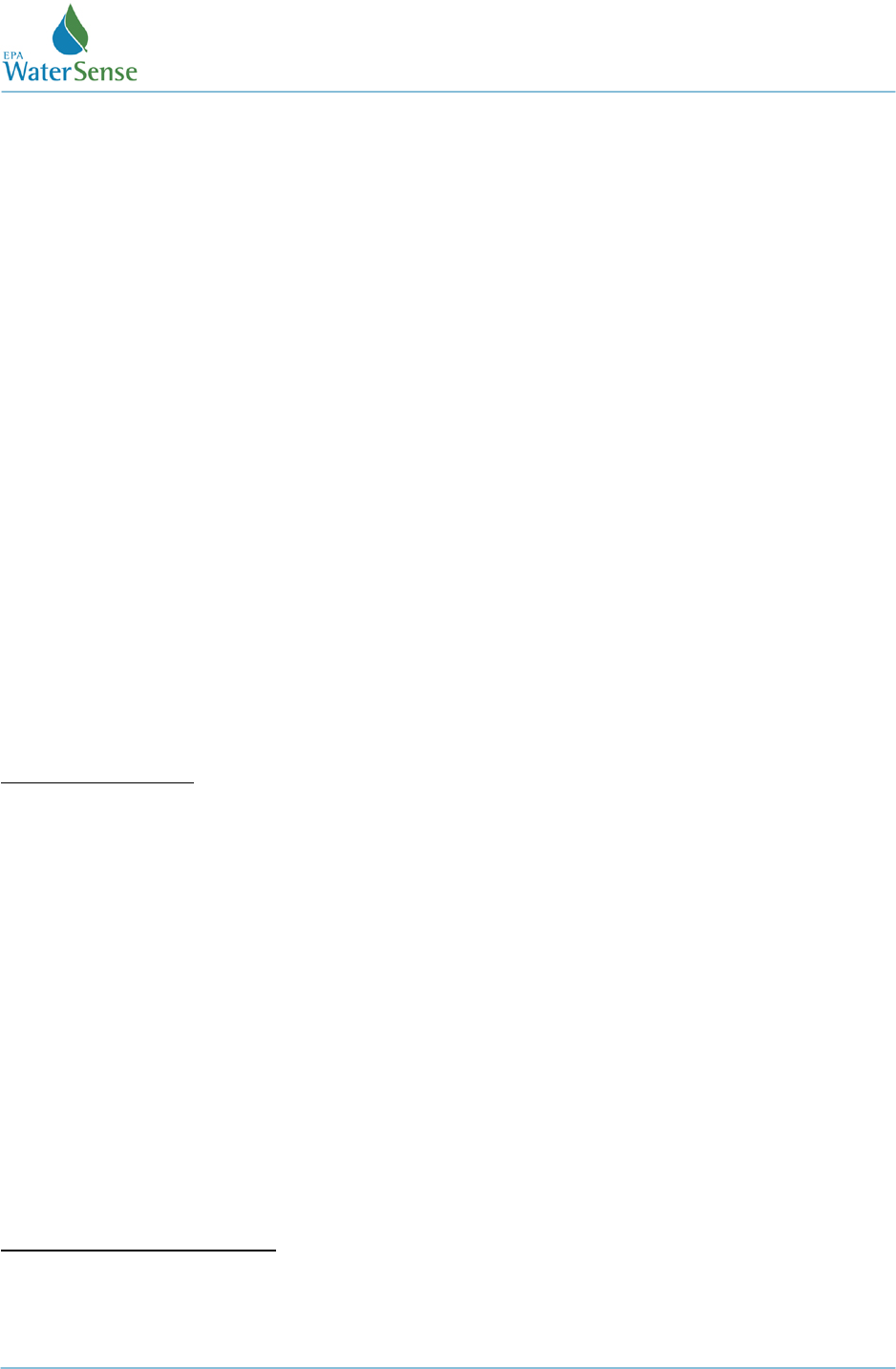
WaterSense
®
Water Budget Approach
research done in California and are also used by the U.S. Green Building Council’s Leadership
in Energy and Environmental Design (LEED
®
) for Homes Rating System (2008). As better data
become available nationwide, WaterSense intends to revise the tool to incorporate these
advances.
Appropriate Uses of the Tool
As discussed, the data chosen for the tool represent conservative estimates for the major
variables included in the tool. Additionally, generalizations and assumptions were made in order
to simplify the tool and make it applicable nationwide. The tool functions well for its intended
purpose of promoting a conservative landscape design. However, it should not be used to
determine irrigation scheduling amounts, as it would likely result in the over-application of water.
Local sources of real-time data are more appropriate for this purpose.
Explanation of Calculations
Baseline
In order to determine which landscapes are water-efficient, there must be a standard against
which to judge water use. The Water Budget Tool set the baseline amount of water at the
amount of water required by a site if the landscaped area is watered at 100 percent of local
reference evapotranspiration (ET
o
). ET
o
is representative of the amount of water lost from a
well-maintained expanse of average-height green grass and the surrounding soil.
3
It varies by
region, depending on the amount of sun, wind, humidity, and temperature at a location. Hot, dry,
and windy locations have higher ET
o
values than cool, humid locations. As explained above,
this tool uses data based on 30-year historical averages for these variables.
Equation 1: Baseline
uo
CA
ETBaseline
××=
Where:
ET
o
= Local reference evapotranspiration (inches/month)
A = Landscaped area (square feet)
C
u
= Conversion factor (0.6233 for results in gallons/month)
Landscape Water Allowance
The landscape water allowance (LWA) is the amount of supplemental water allotted for the
designed landscape. For purposes of the specification, the LWA is 70 percent of the baseline
amount of water that would be needed if the entire landscape was covered by a well-maintained
expanse of average-height green grass.
The water budget method assumes that all plants will require some amount of supplemental
water. EPA has assumed that a landscape will have a variety of vegetation that have different
3
Irmak, S. and D. Haman. 2003. "ABE 343: Evapotranspiration: Potential or Reference?" Agricultural and
Biological Engineering Department, Florida Cooperative Extension Service, Institute of Food and
Agricultural Sciences, University of Florida.
Version 1.02 3 July 24, 2014

WaterSense
®
Water Budget Approach
water needs and that none of the vegetation in a residential landscape will need 100 percent of
ET
o
. Thus, the allotment can be met by incorporating a mixture of high, medium, and low water-
using plants in the design of the landscape. The LWA does not mean that each plant is only
given 70 percent of the water it needs to survive.
Equation 2: Landscape Water Allowance
BaselineLWA ×= 70.0
Where:
LWA = Landscape water allowance (gallons/month)
Landscape Water Requirement
The landscape water requirement (LWR) is the amount of supplemental water required by the
design of the established landscape. The LWR is calculated by dividing the landscape into
hydrozones, determining the LWR for each hydrozone, and then adding these totals together.
Separate hydrozones should be calculated for each category of vegetation planted (trees,
shrubs, groundcover, turfgrass). Additional hydrozones should be calculated within vegetation
categories if different types of irrigation equipment are used on the same type of planting.
The LWR is based on ET
o
, the landscape coefficient, the area of the hydrozone, the lower
quarter distribution uniformity (DU
LQ
) of the associated type of irrigation equipment, and a
portion of local rainfall designated as allowable rainfall (R
a
). The landscape coefficient (K
L
) is a
factor used to modify ET
o
that factors in the different vegetation species planted (the species
factor [K
s
]); the conditions at the location where vegetation is planted, such as the amount of
sun and wind (the microclimate factor [K
mc
]); and how closely the plants are grouped together
(the density factor [K
d
]). K
L
= K
s
x K
mc
x K
d
. Both K
d
and K
mc
range from 0.5 to 1.4, therefore, for
the purposes of this tool, WaterSense is assuming K
d
and K
mc
are both approximately equal to
1.0 (their average values) to reduce the complexity of the calculations and simplify the equation
to K
L
= K
S
.
The first step of calculating the LWR for a hydrozone consists of modifying ET
o
according to
plant type. Since ET
o
is based on the water requirements of a high water-using grass, relative
percentages of ET
o
are set as the requirements for different categories of vegetation. Low
water-using plants, such as a native groundcover, require a much lower percentage of ET
o
than
a high water-using tree, such as a fruit tree. As explained above, the percentages used to
modify ET
o
in the tool are not exact determinations of the water requirements of specific
plantings, but are relative percentages based on a limited amount of data compiled on the water
use of vegetation in California. Pools, spas, and ornamental water features are assigned the
same coefficient as high water-using turfgrass to account for the high amount of evaporation
expected from these features.
After ET
o
is modified to account for vegetation type, the LWR is further reduced by the amount
of water that can be supplied by precipitation. For the purposes of this tool, WaterSense is
allowing 25 percent of the 30-year historical average rainfall to be counted toward a plant’s
needs. Some portion of each rain event cannot be used by plants, such as rain that falls in
short, extreme bursts and washes away before infiltrating the soil. Estimates of the amount that
is useful to plants, commonly referred to as “effective rainfall,” vary depending on a number of
Version 1.02 4 July 24, 2014

WaterSense
®
Water Budget Approach
factors but is often considered to be approximately 50 percent.
4
The rainfall allowance in this
tool is a fraction of effective rainfall and leads to a more conservative landscape design. This
landscape design will be more resilient in drier-than-average years or periods of unexpected
drought.
Irrigation systems rarely water plants with 100 percent efficiency. For example, water sprayed
from nozzles can be affected by moderate amounts of wind and the shape of a landscape
design may not match the pattern in which water is distributed. This results in some areas of the
landscape receiving less water than the rest of the landscape. To avoid patches of wilted
vegetation, irrigation systems are scheduled to deliver more water than the amount required
based solely on the type of vegetation. This tool modifies the LWR using average lower-quarter
distribution uniformity (DU
LQ
) values for each type of irrigation equipment. Distribution uniformity
is the measure of uniformity of irrigation water applied over an area. DU
LQ
is the ratio of the
average of the lowest 25 percent of measurements to the overall average measurement.
This is in excess of what would typically be required when scheduling an irrigation system,
which should be based on site-specific conditions and minimized as much as possible, but is
included in the tool to promote a more conservative landscape design. The data for the irrigation
type and DU
LQ
are based on the Irrigation Association’s Landscape Irrigation Scheduling and
Water Management (IA 2005).
If irrigation systems are not being installed on the site by the builder, an irrigation type still must
be designated for each plant type and any pools, spas, or ornamental water features. For low
water-using trees, shrubs, and groundcover, standard drip irrigation is assumed. For all other
categories of vegetation, fixed spray irrigation is assumed. This is to account for the type of
system that might be installed after the home is sold. For the same reason, if irrigation systems
are only installed on a portion of the landscape (e.g., only on turfgrass but not on shrubs), the
remaining portions of the designed landscape must use the same assumptions. The
specification requires that pools, spas, and ornamental water features be treated as turfgrass for
single-family homes.
5
Thus, for the purposes of the tool, for single-family homes, these features
are assigned fixed spray irrigation in order to account for the expected replacement of water lost
to evaporation. Areas containing permeable hardscape (e.g., porous pavement) or non-
vegetated softscape (e.g., mulched areas) are assigned no irrigation and do not count toward
the landscape water requirement.
Equation 3: Landscape Water Requirement
uaLo
LQ
H
CARKET
DU
LWR ××−××= ])[(
1
Where:
LWR
H
= Landscape water requirement for the hydrozone (gallons/month)
DU
LQ
= lower quarter distribution uniformity (dimensionless)
ET
o
= Local reference evapotranspiration (inches/month)
K
L
= Landscape coefficient for the highest water-using plant in that hydrozone (dimensionless)
4
Irrigation Association (IA). 2005. Landscape Irrigation Scheduling and Water Management. [Currently
out for review].
5
For multi-family buildings, common-use pools/spas and all areas that are reserved for private use of a
particular residence/unit are excluded from the landscaped area.
Version 1.02 5 July 24, 2014

WaterSense
®
Water Budget Approach
R
a
= Allowable rainfall, designated by WaterSense as 25% of the site’s peak monthly rainfall
A = Area of the hydrozone (square feet)
C
u
= Conversion factor (0.6233 for results in gallons/month)
Results
The final part of the tool displays the water allowance and water requirement calculated for the
designed landscape. The LWR must be less than the allotted amount in order for the landscape
design to meet the criterion in the specification.
The tool also calculates and displays the total amount of turfgrass used in the landscape.
Lastly, the tool displays the percent water reduction achieved by the designed landscape. This
information may be used for a variety of purposes, such as comparing different landscape
designs to choose which would be the most efficient design for a particular location.
II. Instructions for the Excel-Based Version of the Water Budget Tool
Each worksheet is formatted in an identical fashion:
• The blue section at the top displays the user, builder, and site information. Once the
information is entered for Part 1, it is automatically populated into Parts 2 and 3 of the
tool.
• The yellow section displays the equation(s) used in each worksheet.
• The gray section is the area of the worksheet where the user enters the required data.
• The green section displays the result.
Note: The tool only allows information to be entered into the white cells.
Before completing the tool, the user will need to gather the required peak watering month, ET
o
,
and rainfall data from the Water Budget Data Finder
, as well as information regarding the
proposed vegetation and irrigation system equipment. To use the Water Budget Data Finder,
enter the zip code in which the home is being built. It will display the required inputs, which will
be verified as part of the process for inspecting the home.
Part 1: Determining the Baseline and Landscape Water Allowance
1. Complete the site information in the blue section at the top of the worksheet. Enter the peak
watering month for the site. Also, choose “yes” or “no” to indicate whether an irrigation
system is being installed on the site.
2. Complete Step 1A by entering the area of the landscape in square feet. The landscaped
area is defined as “The designed area of landscape excluding the footprint of the home and
permanent hardscape areas such as driveways, sidewalks, and patios. Septic drainage
fields and public right-of-ways should also be excluded from this calculation.”
3. Complete Step 1B by entering the ET
o
in inches obtained from the Water Budget Data
Finder for the site’s peak month.
4. The baseline and LWA are displayed.
Version 1.02 6 July 24, 2014
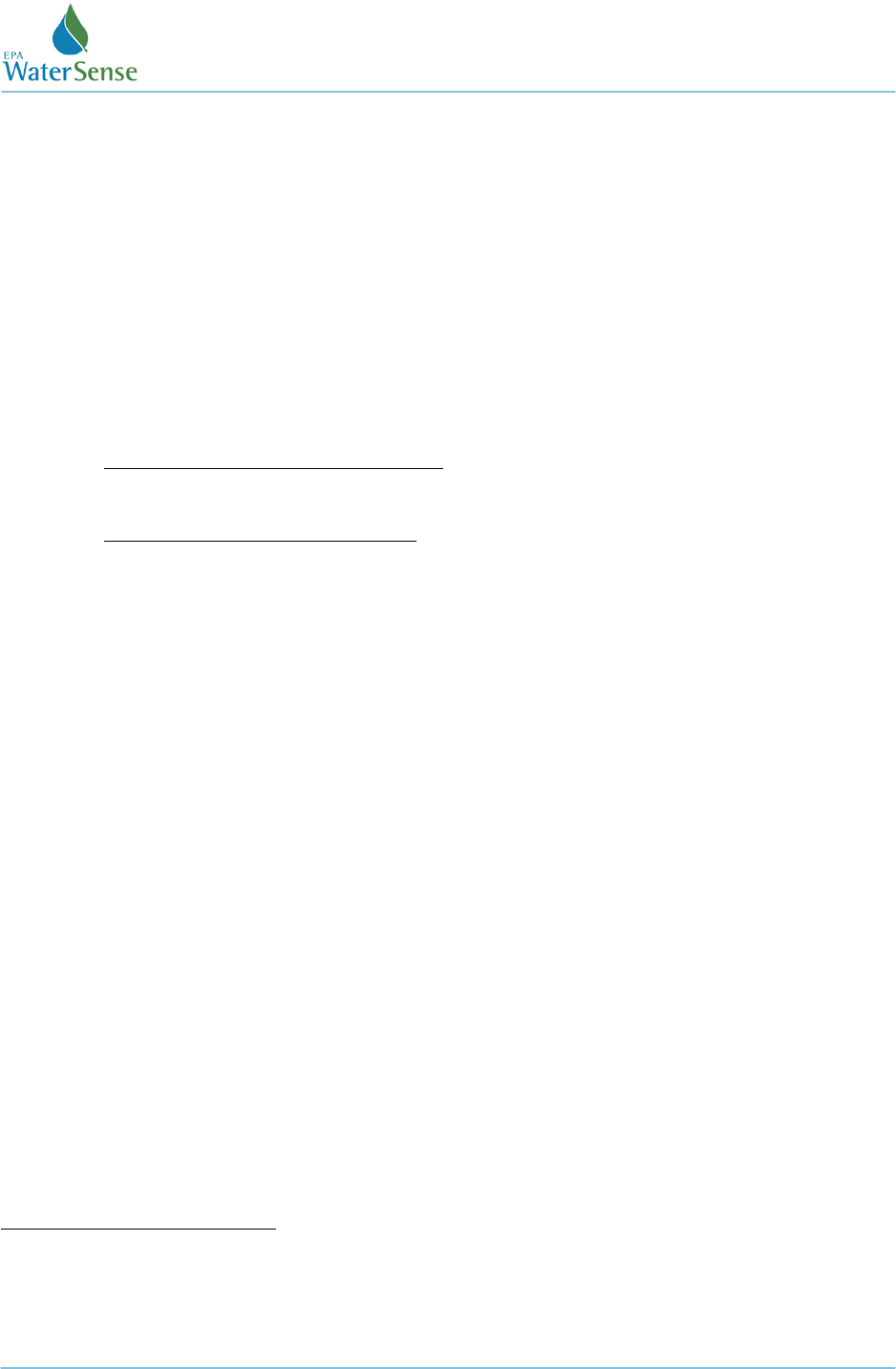
WaterSense
®
Water Budget Approach
5. Click on the worksheet tab labeled “Part 2—LWR” at the bottom of the screen to calculate
the landscape water requirement.
Part 2: Determining the Landscape Water Requirement
1. Complete Step 2A by entering the rainfall in inches obtained from the Water Budget Data
Finder for the site’s peak watering month.
2. Complete Step 2B by filling Table 1 with the required information. The information should
reflect the proposed design of the established landscape. When completed, the total area of
all of the hydrozones/landscape feature areas must equal the landscaped area entered in
Part 1 to avoid an error message in Part 3. For each hydrozone/landscape feature area,
complete the following information:
a. Hydrozone/Landscape Feature Area: Enter the area of the hydrozone or landscape
feature in square feet.
Plant Type or Landscape Feature: From the drop-down list, choose the plant type
(e.g., trees—high water requirement, turfgrass—medium water requirement, etc.) or
landscape feature (e.g., permeable hardscape, non-vegetated softscape, or pool,
spa, or water feature) for the associated hydrozone/landscape feature area. If there
are multiple plant types or landscape features within one hydrozone, enter the
feature with the highest water requirement. The landscape coefficient (K
L
) for the
respective plant type (or landscape feature) will automatically populate in the
adjacent cell.
In general, a high value for K
L
is used for plants that need a lot of water, and a low
value is used for plants that need little water. As a general rule of thumb, species
requiring the indicated amounts of water are designated as follows
6
:
• High K
L
: Species that need more water than most plants within that type of
vegetation (e.g., trees, shrubs, groundcover, turfgrass) or use 70 to 90
percent of ET
o
.
• Moderate K
L
: Species that need a typical amount of water as compared to
other plants within that type of vegetation or use 40 to 60 percent of ET
o
.
• Low K
L
: Species that need less water than most plants within that type of
vegetation or use less than 30 percent of ET
o
.
If you are not familiar with the K
L
values for the proposed plant types, contact your
local cooperative extension, nursery, or landscape professional for guidance.
For permeable hardscape and non-vegetated softscape, the K
L
is assumed to be
zero and no water requirement will be assigned in Table 1. For a pool, spa, or water
feature, the associated K
L
is set at 0.8.
6
University of California Cooperative Extension and California Department of Water Resources. 2000. A
Guide to Estimating Irrigation Water Needs of Landscape Plantings in California. The Landscape
Coefficient Method and Water Use Classifications of Landscape Species (WUCOLS) III.
Version 1.02 7 July 24, 2014
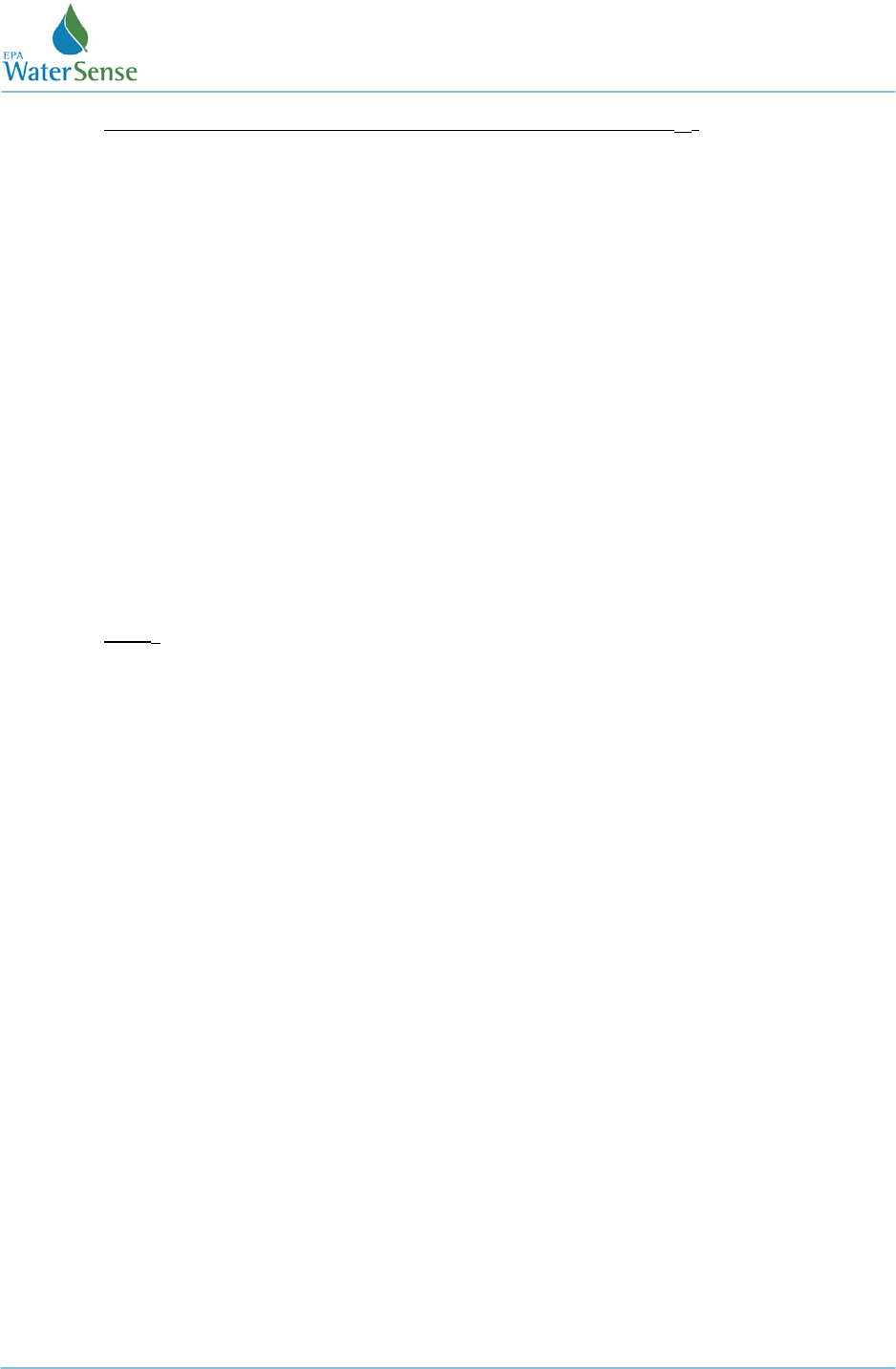
WaterSense
®
Water Budget Approach
b. Irrigation Type and Lower Quarter Distribution Uniformity (DU
LQ
): For each
hydrozone, choose the type of irrigation (e.g., standard drip, rotor) that will be
installed. According to the specification, sprinkler irrigation (fixed spray and rotor)
may only be used on areas of turfgrass that are not on slopes greater than 4:1 (i.e.,
25 percent or 14
o
) or strips less than 4 feet wide. The associated DU
LQ
will
automatically populate in the adjacent cell.
Note: If the hydrozone/landscape feature area is designated as permeable
hardscape or non-vegetated softscape then choose “no irrigation” from the drop-
down list. For single-family homes, if the hydrozone/landscape feature area is
designated as “Pool, Spa, or Water Feature,” then set the irrigation type to “fixed
spray.”
If irrigation is not being installed on the site at this time: Although not installing
irrigation, an irrigation type must be chosen. Use the following types of irrigation as
indicated:
• Drip-Standard: Low water-using trees, shrubs and groundcover.
• Fixed Spray: All turfgrass categories and medium and high water-using trees,
shrubs, and groundcover.
• No Irrigation: Permeable hardscape and non-vegetated softscape areas.
c. LWR
H
: The LWR for each hydrozone, in gallons per month, will be calculated by the
tool and displayed in this column.
3. The result is displayed in the green section.
4. Click on the worksheet tab labeled “Part 3—Results” at the bottom of the screen to review
the results of the Water Budget Tool.
Part 3: Results
If the total area of the hydrozone/landscape feature areas entered in Part 2 does not equal the
landscaped area entered in Part 1, an error message in red text will appear at the top of the
gray section requesting that Table 1 be completed.
1. Review the LWA and LWR calculated in Part 1 and Part 2.
2. Review the total area of turfgrass in the designed landscape. The percentage of designed
landscape that is composed of turfgrass, pools, spas, and/or water features is also
displayed.
3. The result is displayed in the green section.
a. If the blue cell displays “Yes” then the water budget criterion is met (i.e.,
LWR < LWA).
b. If the blue cell displays “No” then the designed landscape requires more water than
the site is allotted. Adjustments should be made to the composition of the landscape
and/or irrigation system in Step 2B of the Water Budget Tool. Then return to Part 3—
Results to see if the revised design meets the water budget criterion.
Version 1.02 8 July 24, 2014
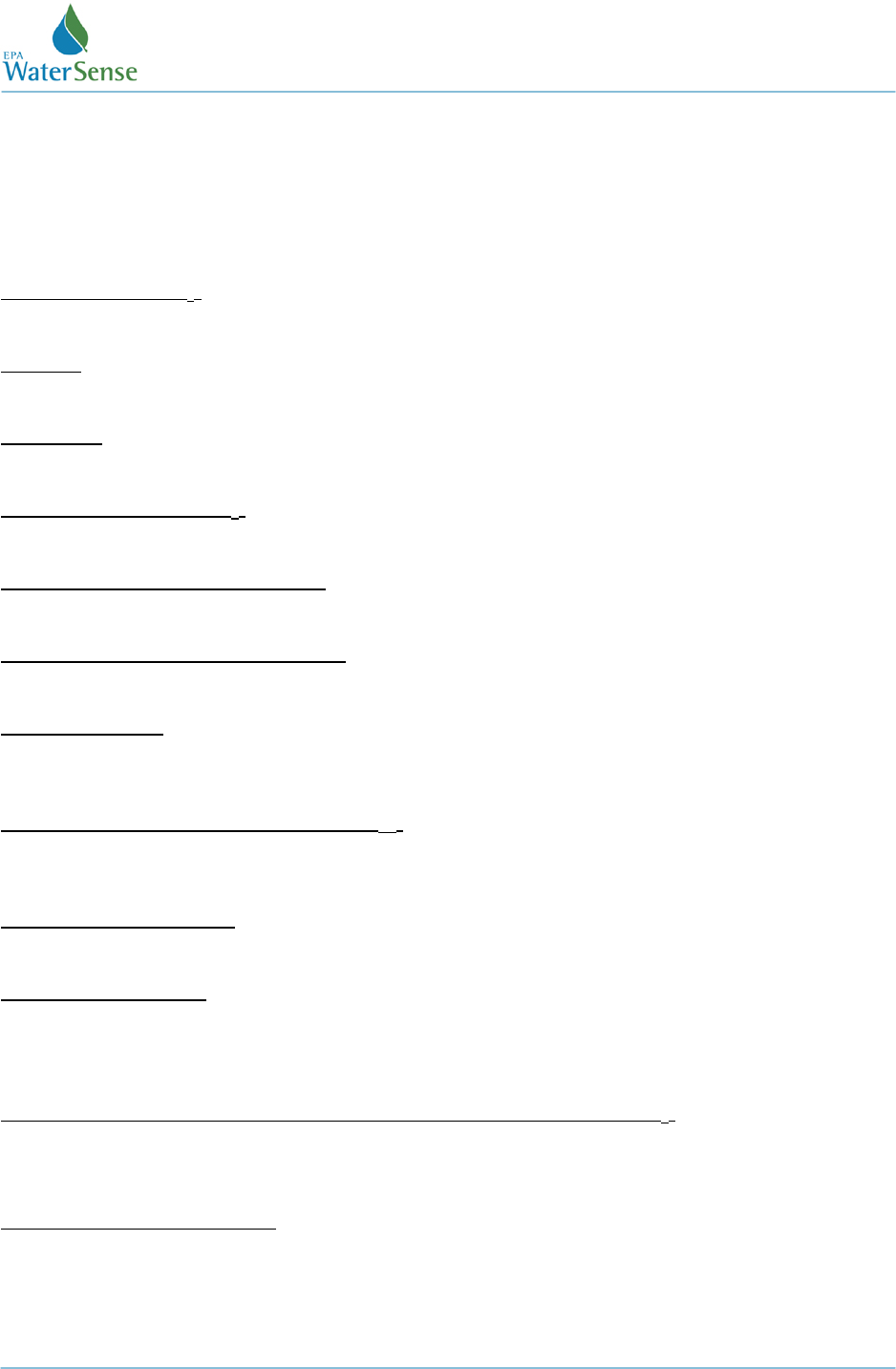
WaterSense
®
Water Budget Approach
When all of the information has been entered into the tool and the water budget has been met,
print an entire copy of the completed tool and submit it to the builder to be included in the
inspection documentation. This documentation must be provided to the builder prior to a home
being inspected for compliance with EPA criteria.
III. Definitions
Allowable rainfall (R
a
): The amount of rainfall WaterSense is allowing to be incorporated into the
water budget.
Baseline: The amount of water required by a site if watered at 100 percent of local reference
evapotranspiration (ET
o
).
Hydrozone: Grouping of plants with similar water and environmental requirements for irrigation
with one of more common station/zone valves.
7
Landscape coefficient (K
L
) : Coefficient used to modify reference ET, which includes a species
factor (K
s
), density factor (K
d
), and microclimate factor (K
mc
). (K
L
= K
s
x K
d
X K
mc
).
8
Landscape water allowance (LWA): A volume of water allocated to the entire landscape area
over a specified period of time.
Landscape water requirement (LWR): The amount of water required by the landscape over a
specified period of time.
Landscaped area (A): The designed area of landscape excluding the footprint of the home and
permanent hardscape areas such as driveways, sidewalks, and patios. Septic drainage fields
and public right-of-ways should also be excluded from this calculation.
Lower quarter distribution uniformity (DU
LQ
): Distribution uniformity is the measure of uniformity
of irrigation water applied over an area. DU
LQ
is the ratio of the average of the lowest 25 percent
of measurements to the overall average measurement.
Non-vegetated softscape: Areas of the landscape that are not hardscape and not planted (e.g.,
mulched areas).
Permeable hardscape: Material that covers the ground but allows water and oxygen to
penetrate the soil. A concrete driveway would be impermeable hardscape whereas brick without
mortar on sand would be permeable hardscape. Other common permeable hardscapes include
decomposed granite, patio blocks, or flagstone surfaces, as long as no mortar is used.
Reference evapotranspiration (grass reference evapotranspiration) (ET
o
): Rate of
evapotranspiration from an extensive surface of cool season grass cover of a uniform height of
12 centimeters, actively growing, completely shading the ground, and not short of water.
9
7
Weinberg and Roberts 1988 and Water Management Committee 2001 in Irrigation Association (IA).
2005. Landscape Irrigation Scheduling and Water Management. [Currently out for review]
8
Landscape 2000 in Irrigation Association (IA). 2005. Landscape Irrigation Scheduling and Water
Management. [Currently out for review].
Version 1.02 9 July 24, 2014

WaterSense
®
Water Budget Approach
Water budget: A water budget is used to calculate the amount of water a landscape needs,
taking into account the inputs and outputs of water to and from the root zone. Inputs, such as
precipitation, are subtracted from outputs, such as evapotranspiration, to calculate the water
needs of the landscape. Many factors are taken into consideration when calculating a water
budget, such as plant type and irrigation system efficiencies.
9
FAO 1998 and ASCE 1990 in Irrigation Association (IA). 2005. Landscape Irrigation Scheduling and
Water Management. [Currently out for review]
Version 1.02 10 July 24, 2014

WaterSense
®
Water Budget Approach
IV. Example
A new home in Chicago, Illinois, is being constructed on a 1/3-acre lot. The area remaining after
subtracting the square footage of the home, driveway, and sidewalk is 12,280 square feet (ft
2
).
The builder is providing landscape for the entire yard and an irrigation system will be installed
for all portions of the landscape. The builder plans to use vegetation from three main categories:
high water-using turfgrass, medium water-using shrubs, and low water-using groundcover.
Additionally, there will be a 150-square-foot deck and some areas that are not vegetated, but
covered with mulch.
Fixed spray irrigation is going to be installed on the turfgrass and standard drip irrigation is
going to be installed for the shrubs and groundcover.
According to the Water Budget Data Finder, the peak watering month for Chicago (zip code
60653) is June. ET
o
during June is 6.43 inches and the average rainfall is 3.56 inches.
The builder completes the WaterSense Water Budget Tool and comes up with the following:
• 7,150 ft
2
high water-using turfgrass
• 2,200 ft
2
medium water-using shrubs
• 2,030 ft
2
low water-using groundcover
• 900 ft
2
non-vegetated softscape (includes deck)
This design meets the water budget using turfgrass on 58 percent of the landscaped area. The
builder achieves a 30 percent designed water use reduction from the baseline scenario.
Version 1.02 11 July 24, 2014
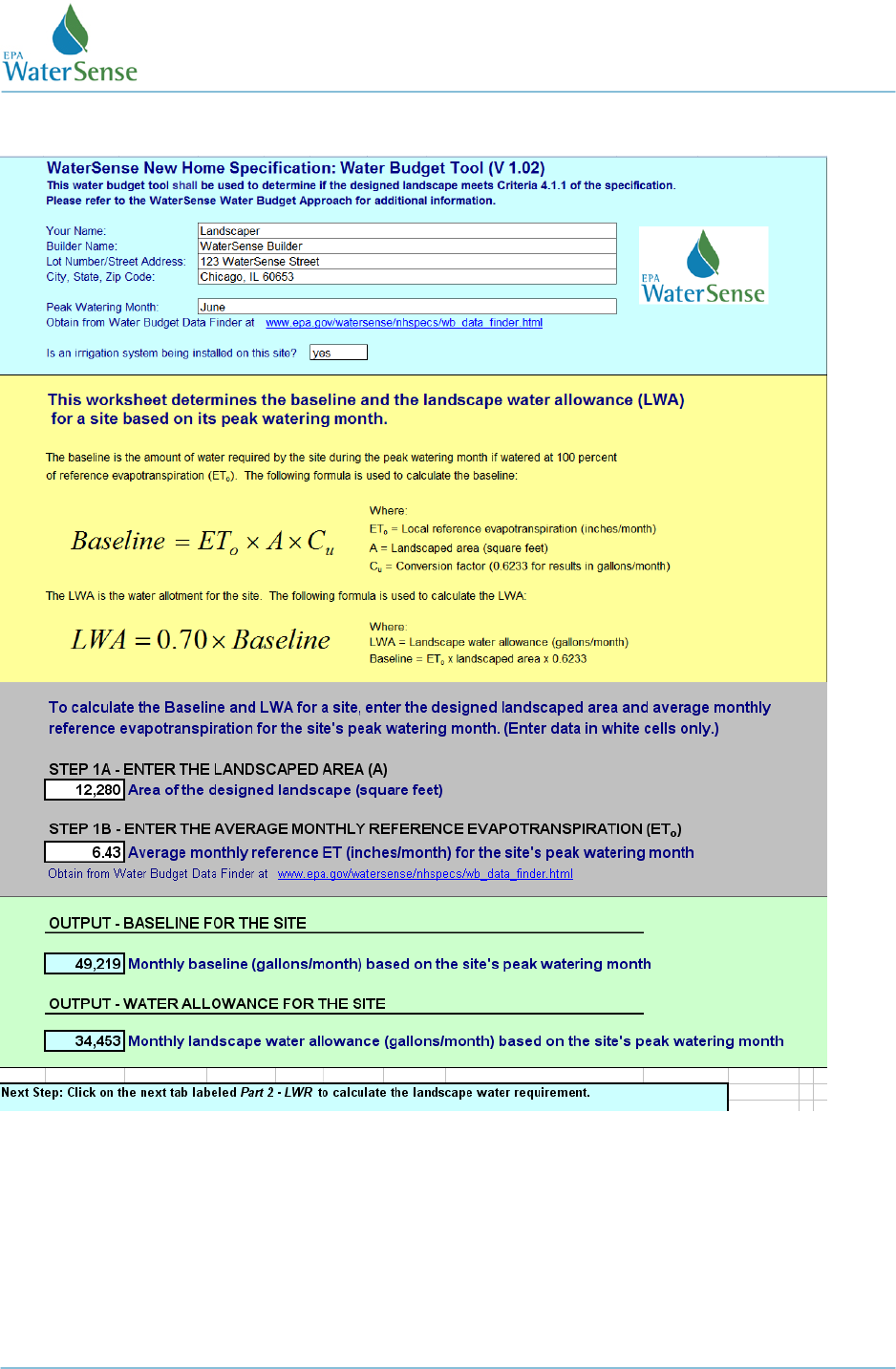
WaterSense
®
Water Budget Approach
Part 1 – Baseline & LWA
Version 1.02 12 July 24, 2014
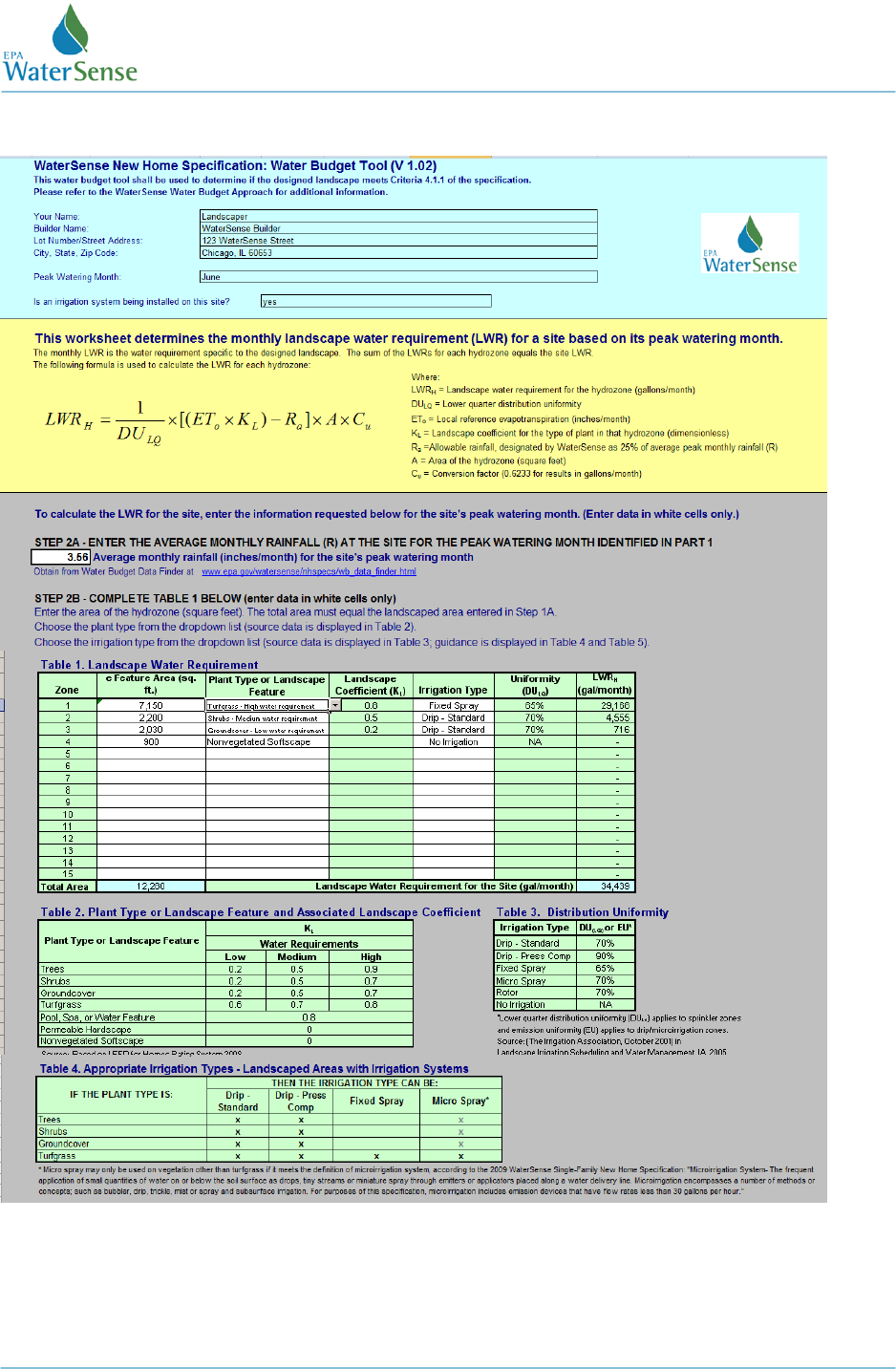
WaterSense
®
Water Budget Approach
Part 2 – LWR
Version 1.02 13 July 24, 2014
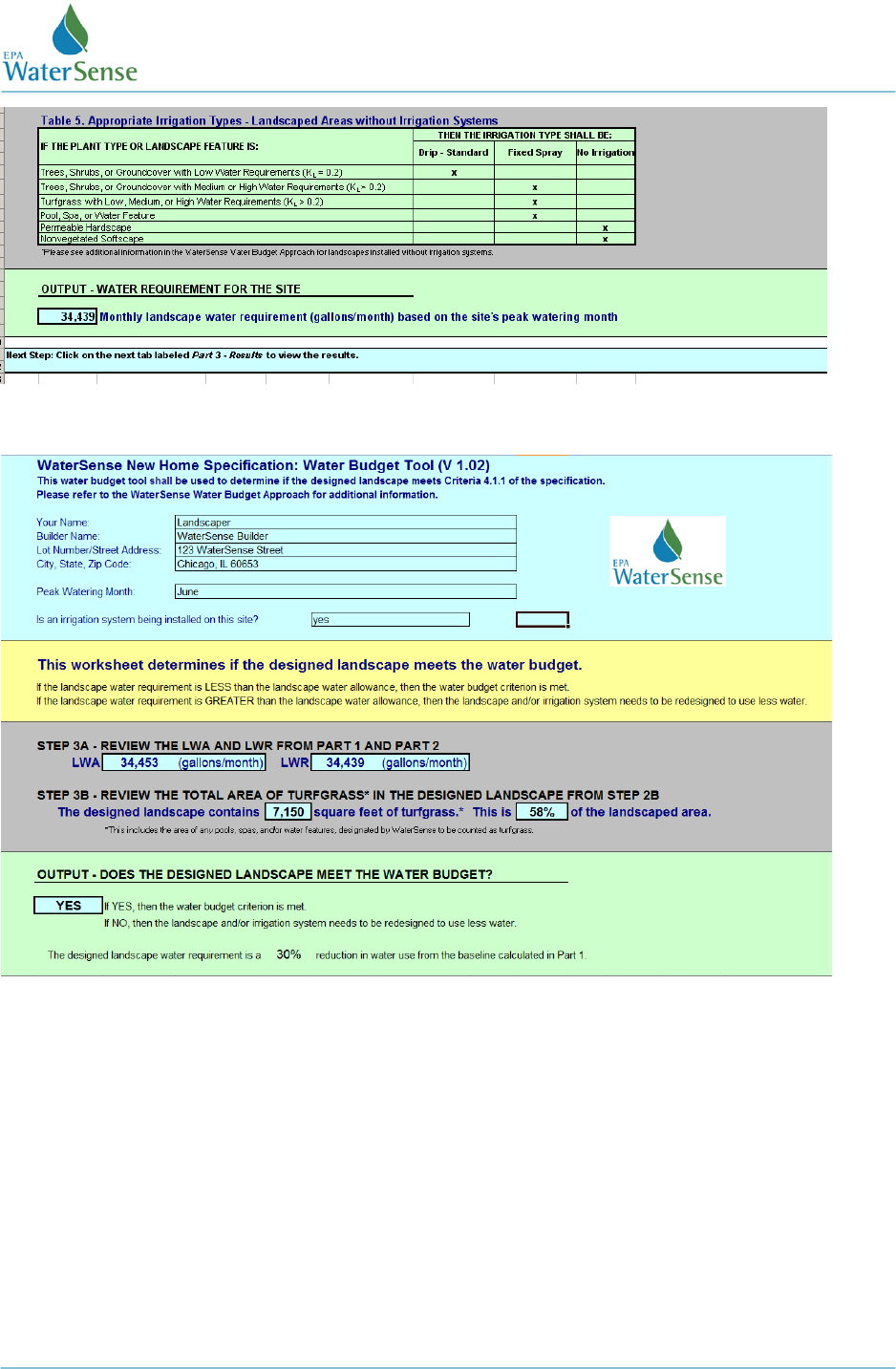
WaterSense
®
Water Budget Approach
Part 3 – Results
Version 1.02 14 July 24, 2014
